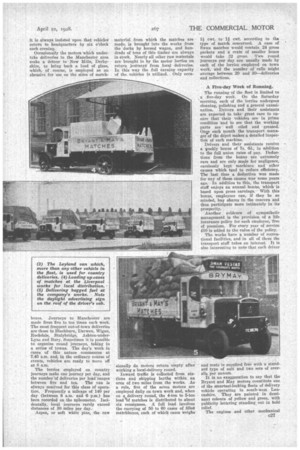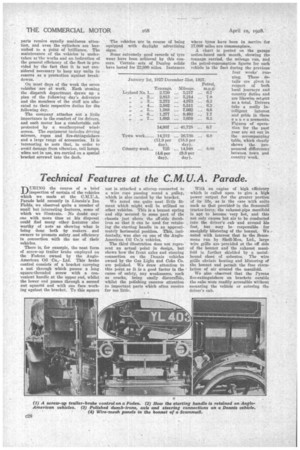THE WORK OF A MATCH MAKER'S FLEET.
Page 48

Page 49

Page 50

If you've noticed an error in this article please click here to report it so we can fix it.
Sharply Contrasting Conditions of Operation are Particularly Noticeable in the Transport Activities of Bryant and May, Ltd.
THERE are not many companies which can claim to have operated business motors from the earliest days of practical transport by this class of vehicle, that is, towards the end of the 19th century. . In the year . 1898, Bryant and May, Ltd., the well-known match manufacturer, foresaw the epoch-making possibilities of this new instrument of transport and purchased far service in connection with its Liverpool • works a 6 h.p. two-cylindered Daimler lorry. of 15 cwt. capacity and equipped with tiller steering and tribe
ignition. .
Its career. was cut short by an accident and the vehicle was replaced hy. another Dabriler with a normal-type steering wheel, four speeds. operated through a quadrant on the steering column and a separate lever fpr. forward and reverse motions, thus enabling the driver to reverse on any of the four speeds. The machine was chain-driven and did not have a radiator, but carried instead a 20-gallon tank from which water for cooling purposes was pumped to the engine. The motor was run until it "fell to pieces," so to speak, after a useful life of six or seven years, quite a goad record for those early days.
Early Users of Motors. .
Since those times Bryant and May, Ltd., has continued its discerning interest in mechanical road transport, After the second Daimler, the concern acquired, in 1907, a 6 h.p. Lacre, which was followed by a 16-20 h.p. Argyle, and later by a Mass tractor, a
20 h.p. Burford, a 40 h.p. Leyland, a 30 h.p: Daimler,a 2-i-ton British Berns and a 3i-tonner of the same Make, two Reliance vans and, latterly, a number of Leylands of different types.
The ''company's Diamond Match Works, at Litherland, Liverpool, are now served ty a fleet of seven 4-ton Leylands. One of these is a van and the Other' six are low-sided-lorries. The
('N
fleet is .operatedwithin an area of 70 miles from Liverpool, but work is carried out chiefly in the Lancashire territory.
In reviewing the uses to which the fleet is put two setsof contrasting conditions stand out, as there are no gradations between what one might-describe as town work on the one hand and -country work on the other. This. reflectsitself
very strikingly in operating statistics. Whilst the motor lorry employed on local deliveries, or town work, clears an average tonnage of 11.9 per day and covers a mileage of 18.8, the figures applying to the average day's work of the vehicle employed on long-distance journeys show tonnage at 4.6 and mileage at 98. The respective petrol-return figures are 6. m.p.g. for town work and 8.08 m.p.g, for country duties. .
In extracting final running 'coats, which task is undertaken at the head London offices of Bryant and May, Ltd., those applying to local journeys are kept separate from the out-of-town deliveries.
The fleet is 'operated according to strict economic standards and approximately 75 per cent. of its gross load-7 carrying capacity is usefully employed. On the country journeys it is rarely possible to acquire return,loads, became It is always insisted upon that vehicles return to headquarters by six &dock each evening.
Occasionally the motors which undertake deliveries in the Manchester area make a detour to New Mills, Derbyshire, to bring back a load of glass, which, of course, is employed as an abrasive for use on the sides of match
boxes. Journeys to Manchester are made from five to ten times each week. The most frequent out-of-town deliveries are those to Blackburn, Darwen, Wigan, Rochdale, Stalybridge, Ashton-underLyne and Bury. Sometimes it is possible to organize round journeys, taking in a series of towns. The day's work in cases of this nature commences at 7.45 a.m, and, in the ordinary course of events, vehicles are ready to move off at 8 a.m.
The lorries employed on country journeys make one journey per day, and the number'of deliveries per load"ranges between five and ten. The van is always reserved for this class of operation. Frequently a mileage of 140 per day (between 8 a.m. and 6 p.m.) has been recorded on the mileometer. Incidentally, local journeys rarely exceed distances of 30 miles per day.
Aspen, or soft white pine, the raw material from which the matches are made, is brought into the works from the docks by horsed wagon, and hundreds of tons of this timber are always in stock. Nearly all other raw materials are brought in by the motor lorries on retarn jolfrueye from local deliveries. In this way the full earning capacity of the vehicles is utilized. Only occa s'onally do motors return empty after working a local-delivery round.
Inward traffic is collected from stations and shipping berths within an area of two miles from the works. As a rule, five of the seven motors are employed daily on town work and, when on a delivery round, the 4-ton to 5-ton load "A matches is distributed to about six consignees. A full load involves the carrying of 50 to 60 cases of filled matchboxes, each of which cases weighs 1-1 cwt. to cwt. according to the
type of match concerned. A ease of Swan matches would contain 24 gross packets and a crate of smaller boxes would take 32 gross. Two round journeys per day are usually made by each of the lorries employed on town work, and the number of calls might average between 20 and 30—deliveries and collections.
A Five-day Week of Running.
The running of the fleet is limited to a five-day week. On the Saturday morning, each of the lorries undergoes cleaning, polishing and a general examination. Drivers and their assistants are expected to take great care to ensure that their vehicles are in prime condition and to see that the working parts are well oiled and greased. One each month the transport manager of the depot makes a detailed inspection of each machine.
Drivers and their assistants receive a weekly bonus of 7s. 6d., in addition to the full union rates of pay. Deductions from the bonus are extremely rare and are only made for negligence, carelessly kept machines and other causes which tend to reduce efficiency. The last time a deduction was made for any of these causes was some years ago. In addition to this, the transport staff enjoys an annual bonus' which is based upon gross earnings. With this bonus, employees can, if they be so minded, buy shares in the concern and thus participate more intimately in its prosperity.
Another evidence of sympathetic management is the provision of a life insurance policy for each employee, free of premium. For every year of service £10 is added to the value of the policy.
The works have a number of recreational facilities, and in all of these the transport staff takes an interest. It is also interesting to note that each driver
and mate is supplied free with a standard type of suit and two sets of overalls per annum.
It is no exaggeration to say that the Bryant and May motors constitute one of the smartest-looking fleets of delivery vehicle operating in south-west Lancashire. They are painted in dominant colours of yellow and green, with publicity lettering standing out in bold relief.
The engines and other mechanical 27 parts receive equally assiduous attention, and even the cylinders are burnished to a point of brilliancy. The maintenance of the vehicles is under taken at works and an indication of the general efficiency of the fleet is provided by the fact that it is not considered necessary to keep any units in reserve as a precaution against breakdowns.
On most days of the week the seven vehicles are at work. Each evening the dispatch department draws up a plan of the following day' e deliveries and the members of the staff are allocated to their respective duties for the following day.
The company attaches not a little importance to the comfort of its drivers, and each motor has a comfortable cab protected by a weatherproof windscreen. The equipment includes driving mirrors, ropes and fire-extinguishers and a large range of accessories. It is interesting to note that, in order to avoid damage from vibration, tail lamps. when not in use, are carried on a special bracket screwed into the dash. The vehicles are in course of being equipped with daylight advertising signs.
some extremely good records of tyre wear have been achieved by this eoncern. Certain sets of Dunlop solids have lasted for 22,000 miles. Instances where tyres have been in service for 17,000 miles are commonplace.
A. chart is posted on the garage notice-board each month, showing the tonnage carried, the mileage run, and the petrol-consumption figur'es for each vehicle in the fleet during the previous four weeks' runnine.. These detads are given in respect of both local journeys and country duties and are likewise set out as a total. Drivers take a really intelligent interest and pride in these an non neetnents. Figures of operation for the past year are set out in
Petrol.
6.0 the accompanying table, which clearly shows the pro
8.08 not-paced differences between town and country work.












































































































